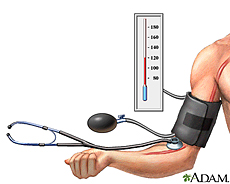 |
 |
 |
Other Health Topics:

-
Related Topics
-
Go Local
- Services and providers for Low Blood Pressure in the U.S.
-
National Institutes of Health
- The primary NIH organization for research on Low Blood Pressure is the National Heart, Lung, and Blood Institute
You've probably heard that high blood pressure is a problem. So what about low blood pressure?
Blood pressure is the force of your blood pushing against the walls of your arteries. Each time your heart beats, it pumps out blood into the arteries. Your blood pressure is highest when your heart beats, pumping the blood. This is called systolic pressure. When your heart is at rest, between beats, your blood pressure falls. This is the diastolic pressure. Your blood pressure reading uses these two numbers. Both are important. Usually they're written one above or before the other, such as 120/80. If your blood pressure reading is 90/60 or lower, you have low blood pressure.
Some people have low blood pressure all the time. They have no symptoms and their low readings are normal for them. In other people, blood pressure drops below normal because of some event or medical condition. Some people may experience symptoms of low pressure when standing up too quickly. Low blood pressure is a problem only if it causes dizziness, fainting or in extreme cases, shock.
National Heart, Lung, and Blood Institute
-
Hypotension
 (National Heart, Lung, and Blood Institute)
(National Heart, Lung, and Blood Institute)
| Basics | Learn More | Multimedia & Cool Tools |
|---|---|---|
|
||
| Research | Reference Shelf | For You |
-
Overviews
- Low Blood Pressure (Hypotension)(Mayo Foundation for Medical Education and Research)
- Your High Blood Pressure Questions Answered -- Low Blood Pressure(American Heart Association)
-
Diagnosis/Symptoms
- Arterial Catheterization(American Thoracic Society) - Requires Flash Player
- Blood Pressure Testing and Measurement(American Heart Association)
- Tilt-Table Test(Mayo Foundation for Medical Education and Research)
-
Disease Management
-
Blood Pressure Monitoring at Home(American Academy of Family Physicians)
Also available in Spanish
-
Blood Pressure Monitoring at Home(American Academy of Family Physicians)
-
Specific Conditions
- Autonomic Nervous System(American Heart Association)
-
Multiple System Atrophy with Orthostatic Hypotension
 (National Institute of Neurological Disorders and Stroke) - Short Summary
(National Institute of Neurological Disorders and Stroke) - Short Summary
-
Orthostatic Hypotension
 (National Institute of Neurological Disorders and Stroke) - Short Summary
(National Institute of Neurological Disorders and Stroke) - Short Summary
- Orthostatic Hypotension (Postural Hypotension)(Mayo Foundation for Medical Education and Research)
- Shy-Drager Syndrome(Mayo Foundation for Medical Education and Research)
-
Clinical Trials
-
ClinicalTrials.gov: Hypotension
 (National Institutes of Health)
(National Institutes of Health)
-
ClinicalTrials.gov: Shy-Drager Syndrome
 (National Institutes of Health)
(National Institutes of Health)
-
ClinicalTrials.gov: Hypotension
-
Journal Articles
References and abstracts from MEDLINE/PubMed (National Library of Medicine)
- Article: Postural orthostatic tachycardia syndrome.
- Article: Effect of hyperosmolality on vasopressin secretion in intradialytic hypotension: a...
- Article: Risk factors for vascular dementia: hypotension as a key point.
- Low Blood Pressure -- see more articles
- Medical Encyclopedia Return to top
-
Organizations
- American Heart Association
-
National Heart, Lung, and Blood Institute

-
National Institute of Neurological Disorders and Stroke

Also available in Spanish
-
Seniors
- Fainting (Syncope)(AGS Foundation for Health in Aging)
- Postprandial Hypotension(Merck & Co., Inc.)
- Steady as You Go: Low Blood Pressure(AGS Foundation for Health in Aging) - Links to PDF
| Home | Health Topics | Drugs & Supplements | Encyclopedia | Dictionary | News | Directories | Other Resources | |
| Copyright | Privacy | Accessibility | Quality Guidelines U.S. National Library of Medicine, 8600 Rockville Pike, Bethesda, MD 20894 National Institutes of Health | Department of Health & Human Services |
Date last updated: 26 June 2008 Topic last reviewed: 03 June 2008 |






